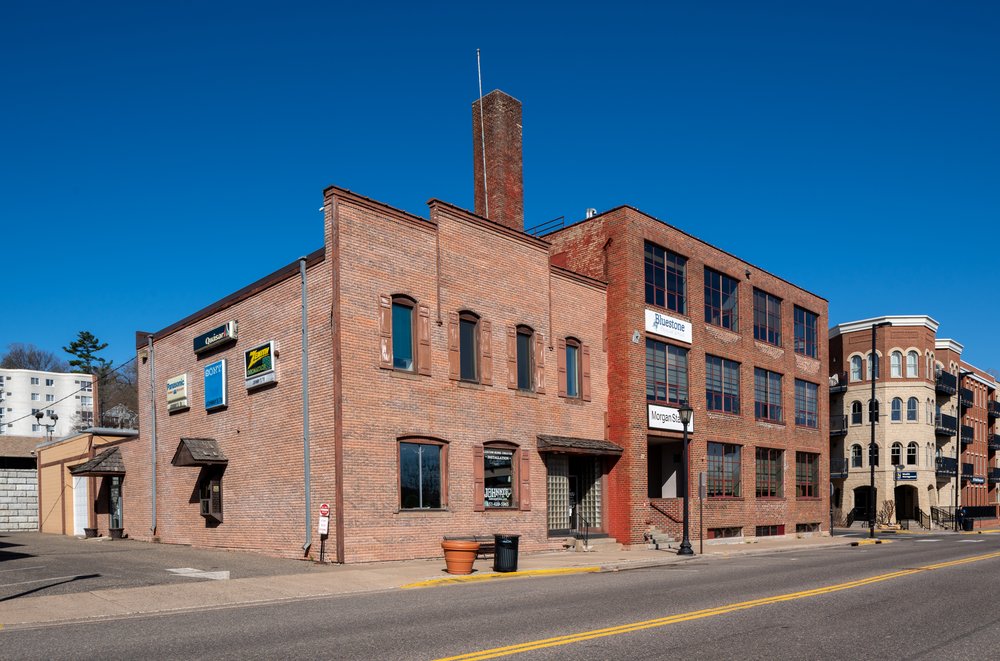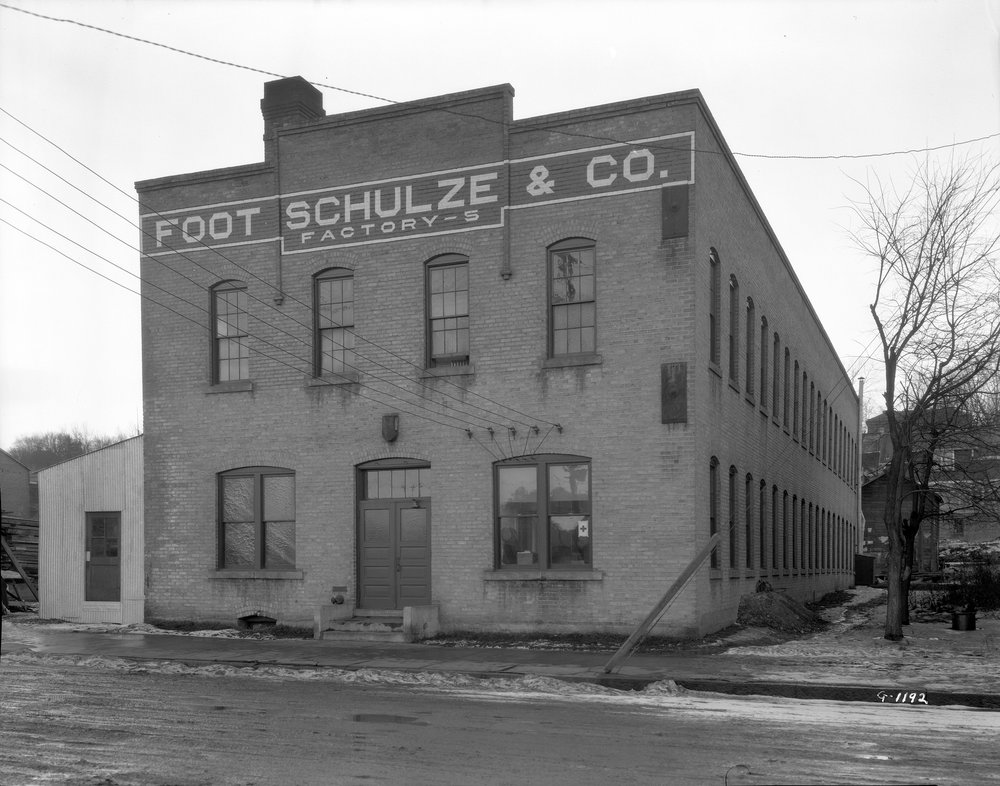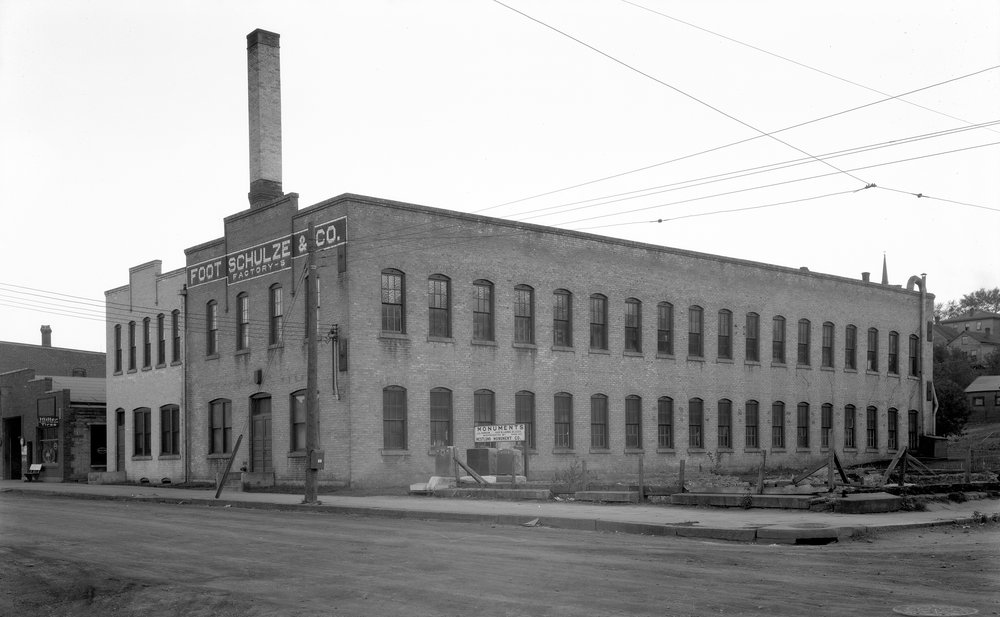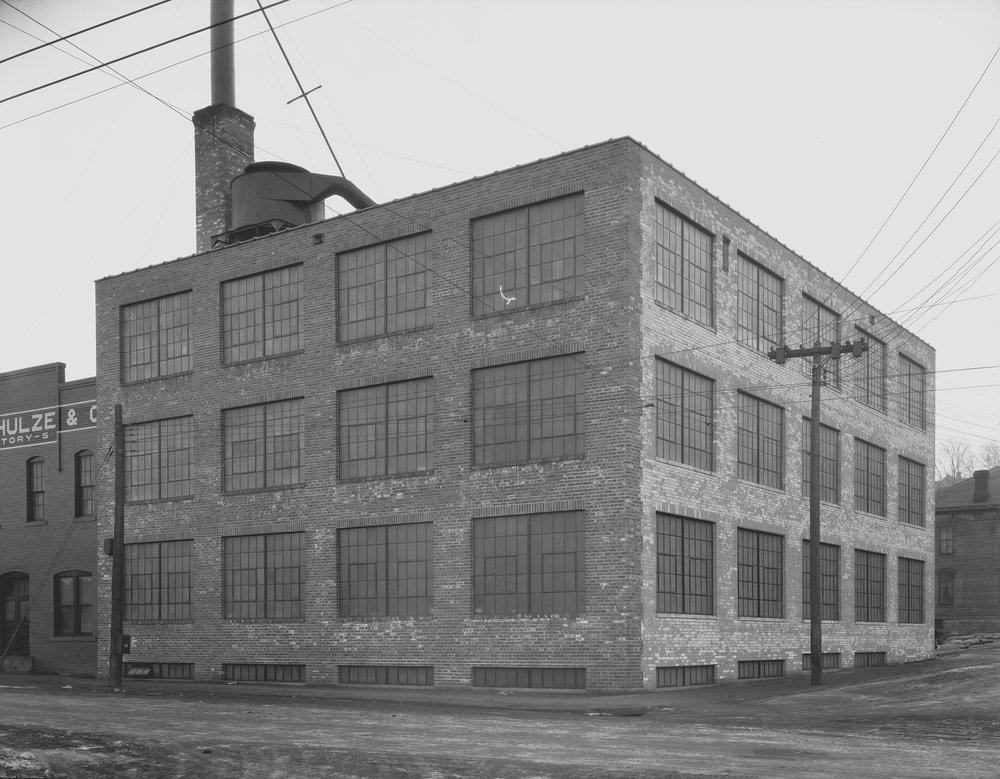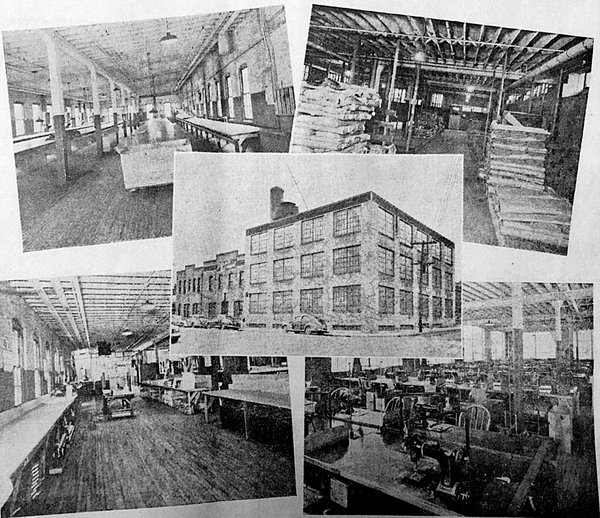Western Shoe Company
At a Glance:
- The two-story south building was constructed in 1911 as the Western Shoe Company’s shoe stitching factory.
- In 1924 and 1925, the Foot-Schulze Company added two smaller additions to the bulding. These no longer exist.
- In 1926, with funding raised by local residents and business leaders, Foot-Schulze expanded by builing the large three-story addition to the north.
- Since the 1960s, Johnny’s TV has been based in the original portion of the factory building.
The Western Shoe Company first appears in the 1904 city directory, led by president Roscoe H. Bronson, vice president A.E. Macartney, secretary Roy G. Staples, general manager William H. Cadwell, and superintendent Thomas F. Connolly. All were Stillwater residents, except for Macartney who lived in St. Paul. Originally, Western Shoe Company was a prison labor operation, with a factory inside the state prison itself. By 1907, the company’s convict laborers were supplemented by approximately 40 civilian employees, some of whom decided to strike. The employees sought a 60-hour work week with wages of $18 per week; the company offered a new per-piece payment model, with a minimum of $16.50 per week. A compromise was reached and most of the 19 strikers returned to work. Apart from wages, one the employees’ concerns was that they were not allowed to start work on the floor until the day shift of prisoners had left the factory, and the proposed per-piece payment would mean that this changeover delay was unpaid time.[1]
A few weeks after the strike, the company purchased expansion land outside the prison, near the intersection of North Main and Mulberry streets. The land does not appear to have been immediately used, however. Meanwhile, leather pieces cut in the prison factory were stitched together at a facility in the Bernheimer building on South Main Street.[2]
In September 1911, the Stillwater Daily Gazette reported that Western Shoe Company would become a permanent Stillwater institution following the expiration of its prison labor contract with the state. The company broke ground on a new factory on the North Main Street property, “preliminary to the erection of a series of buildings there that will eventually be a large concern.” The original company was to be re-organized under new leaders, W.H. Cadwell, John A. Casey (a manager of the prison factory) and Roy G. Staples, and would take over the shoe stitching operations from the previous South Main Street facility. The old company would continue to operate until the expiration of its prison labor contract, at which time it would be absorbed into the new one. The new company announced it would manufacture a line of men’s and youth footwear.[3]
By the time it opened, it opened, the factory on North Main was one of two shoe factories within a block of each other. The competing Connolly Shoe Company was founded in 1906 when a consortium of local merchants, concerned about high unemployment following the end of lumber industry, recruited Western Shoe’s superintendent Thomas F. Connolly to establish his own company outside the prison. The Connolly and Western companies didn’t only compete in business: their company baseball teams planned to compete for a trophy and cash prize in the summer of 1912. The Gazette reported that “the contest is the talk of the town and fans old and of the later vintage have caught the enthusiasm and there will be a good crowd out to see the contest.”[4]
Western Shoe was the last private company using convict labor, and its contract ended with the closure of the old Stillwater prison in 1914. Following that, the Gotzian Shoe Company of Stillwater (whose officers appear to be the same as Western Shoe’s), took over the North Main Street factory building. Gotzian also had facilities in St. Paul, and at least one Stillwater man, W.G. Bronson, worked in the office there. By that September, Gotzian announced that it was seeking 100 laborers—both men and women—to stich shoes at the North Main Street factory.[5]
In 1920, the Gotzian company sold the factory to Foote, Schulze & Company for $1. It’s possible that the two companies were related. In August 1921, Foot-Schulze announced that it planned to produce two kinds of shoes in the former stitching facility on North Main Street. As a result, it planned to hire 150 people, “a large percent of which will be male labor.”[6]
In 1924, Foot-Schulze was still growing. To attract more jobs to Stillwater, a group of local leaders known as the Stillwater Industrial Commission solicited local financial pledges and purchased the lot to the south of the 1911 factory. This was part of a variety of efforts to generate post-lumbering employment in Stillwater. The Gazette took the opportunity to urge more similar efforts:
Right here might be a good place to state that not only the men who are in business but also those who have property to rent, should be as much interested in securing new factories and enlarging factories, as anyone else, and they should do their part.
This new addition to the shoe plant means fifty more employees. It is fair to presume that quite a number will be married men with families. They will need houses or flats to live in. This means business for owners of property to rent.
The right spirit shown by our business men and property owners will secure other desirable factories. The Industrial Commission is entitled to credit for making this new addition to the shoe factory possible.[7]
This new 1924 addition was two stories, 28 feet wide by 33 feet deep. It was designed by the company rather than an outside architect and replicated many elements of the original factory’s front facade design. It was built by the O.H. Olsen Construction Company of Stillwater. In 1925, Stillwater builder Frank Linner constructed another small addition, a 10 by 40 foot storage building of frame (wooden) construction.[8]
Two years later, Foot-Schulze continued to grow and considered factory expansion sites in several cities. Once again, a group of Stillwater business leaders, this time known as the Stillwater Association, raised funds to provide a site for the new factory, just north of the existing factory on land previously occupied by the St. Paul Hotel. The Stillwater Messenger reported that after the completion of the new addition the company would provide employment to around 300 residents.[9]
This 1926 factory addition was much more substantial than the addition built in 1924, and was one of the last pre-WWII industrial buildings in downtown Stillwater. Designed by architectural firm Toltz, King & Day, the plans changed repeatedly during the design process, with the building growing progressively larger each revision. The final design was a three story building of brick and steel, with large windows providing natural light for the factory. The O. H. Olsen company, selected again as general contractor, started work on July 12 and finished around mid-October. M.M. Peaslee of Stillwater had the contract for plumbing and heating. Upon completion, Foot-Schulze hosted a dancing party in the new building.[10]
Just two years later, in 1928, Foot-Schulze closed its St. Paul plant and sold the Stillwater factory to the O’Donnell Shoe Corporation, another St. Paul based manufacturer. By the early 1940s, the factory was occupied by St. Croix Ringer Company—also known as St. Croix Garment Company—a clothing manufacturer owned by Walter M. Ringer and managed by Roy Kerr. In 1942, the company was presented with the Army-Navy "E" Award recognizing its productivity in manufacturing canteen covers and other items for the war effort. At some point after 1956, the smaller 1924 addition was removed from the south side of the original factory. And sometime between 1964 and 1968, the factory closed or relocated.[11]
By 1968, John Fazendin had moved his television dealership, Johnny's TV, to the original 1911 factory building. John's son David and business partner Tom Syverson continue to operate the business there in 2024. In addition to audiovisual equipment, Johnny’s TV became known as a location for movie rentals, and added a drive-through rental window on the south wall.[12]
The other part of the building—the three-story 1924 addition—remained vacant for a time and the property was used for parking. Later, it housed an antique store. In 2024, it was occupied by Bluestone Physician Services and Morgan Stanley.
— Matt Thueson
Matt Thueson is a member of the Stillwater Heritage Preservation Commission.
References
-
“Cutters Go Out”, Stillwater Daily Gazette, May 16, 1907, p. 6. “Will Go To Work”, Stillwater Daily Gazette, May 17, 1907, p. 2.
↩ -
68 Deeds 69.
↩ -
“New Factory Will Be Large”, Stillwater Daily Gazette, September 24, 1911, p. 2.
↩ -
“Shoemakers Play Baseball”, Stillwater Daily Gazette, May 30, 1912, p. 5.
↩ -
“Work At Old Prison Stops”, Stillwater Daily Gazette, July 31, 1914, p. 2. “City and Surroundings”, Stillwater Daily Gazette, September 15, 1914, p. 5.
↩ -
86 Deeds 133. “Good News”, Stillwater Messenger, August 17, 1921, p. 1.
↩ -
“Will Enlarge Shoe Plant”, Stillwater Daily Gazette, October 14, 1924, p. 1.
↩ -
City of Stillwater, Building Permit Application 2070. Charles P. Gibson, “Foot-Schulze Factory Number 5, no address, St. Paul”, ca. 1920, photograph, Minnesota Historical Society. (Though labeled as St. Paul, after close examination this photograph appears to depict the Stillwater factory.) John Runk, Jr., “Foot Schulze and Company factory, Stillwater”, May 14, 1926, photoprint, Minnesota Historical Society.
↩ -
“Constructed Started on New Factory”, Stillwater Messenger, July 14, 1926, p. 1. “Foot-Schulze Co. Unit to Be Completed by October 15”, Stillwater Daily Gazette, September 17, 1926, p. 1.
↩ -
Messenger 7/14/1926. “Heating and Plumbing Contract Awarded to Stillwater Concern”, Stillwater Messenger, July 28, 1926, p. 1. “City and Surroundings”, Stillwater Daily Gazette, October 22, 1926, p. 5.
↩ -
111 Deed 568. Andrew Schmidt, principal investigator, Foot, Schulze and Co. (500 North Robert Street, Saint Paul), Minnesota Individual Property Inventory Form, Minnesota State Historic Preservation Office. 1924-1956 Sanborn fire insurance maps. Stillwater City Directories. Brent Peterson, "Army-Navy E award earned in the St. Croix Valley during WWII," Stillwater Gazette, April 11, 2025, p. 2.
↩ -
1968 Stillwater City Directory. John Fazendin obituary, St. Paul Pioneer Press, September 30, 2007. Julie Kink, "67 years of good reception for local mom and pop", St. Croix Valley Press, September 6, 2013, accessed in May 2024 at https://www.presspubs.com/st_croix/news/67-years-of-good-reception-for-local-mom-and-pop/ article_08a230a2-18da-11e3-b2f0-001a4bcf887a.html.
↩

